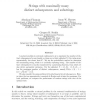Free Online Productivity Tools
i2Speak
i2Symbol
i2OCR
iTex2Img
iWeb2Print
iWeb2Shot
i2Type
iPdf2Split
iPdf2Merge
i2Bopomofo
i2Arabic
i2Style
i2Image
i2PDF
iLatex2Rtf
Sci2ools
COMBINATORICS
2004
2004
Strings with Maximally Many Distinct Subsequences and Substrings
A natural problem in extremal combinatorics is to maximize the number of distinct subsequences for any length-n string over a finite alphabet ; this value grows exponentially, but slower than 2n. We use the probabilistic method to determine the maximizing string, which is a cyclically repeating string. The number of distinct subsequences is exactly enumerated by a generating function, from which we also derive asymptotic estimates. For the alphabet = {1, 2}, (1, 2, 1, 2, . . . ) has the maximum number of distinct subsequences, namely Fib(n + 3) - 1 (1 + 5)/2 n+3 / 5. We also consider the same problem with substrings in lieu of subsequences. Here, we show that an appropriately truncated de Bruijn word attains the maximum. For both problems, we compare the performance of random strings with that of the optimal ones.
Related Content
| Added | 17 Dec 2010 |
| Updated | 17 Dec 2010 |
| Type | Journal |
| Year | 2004 |
| Where | COMBINATORICS |
| Authors | Abraham Flaxman, Aram Wettroth Harrow, Gregory B. Sorkin |
Comments (0)

